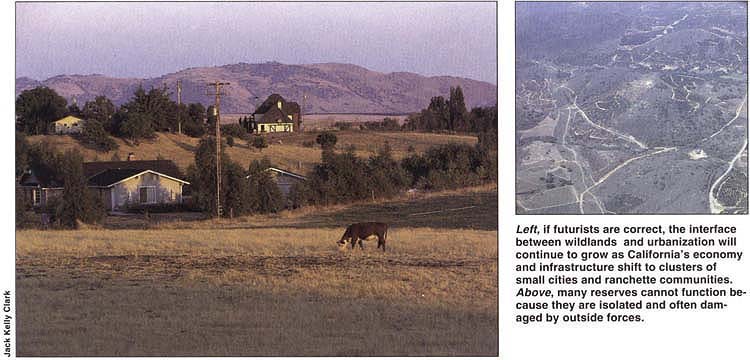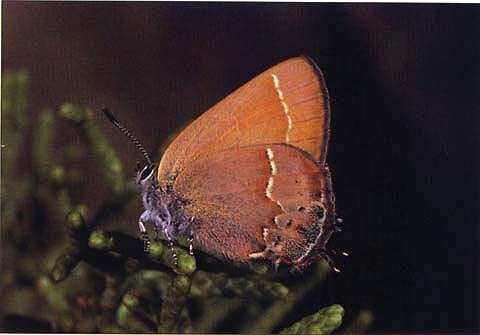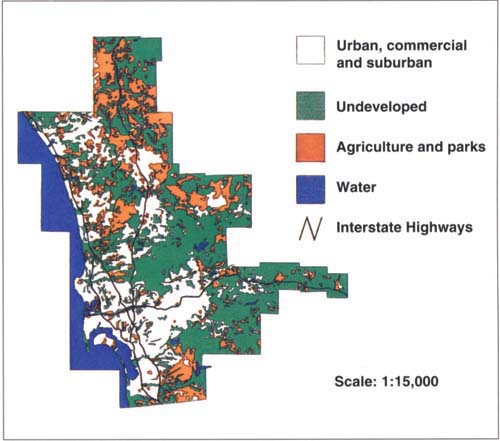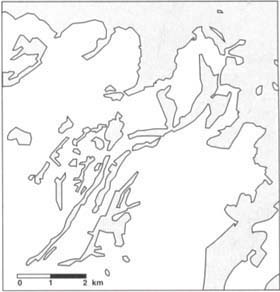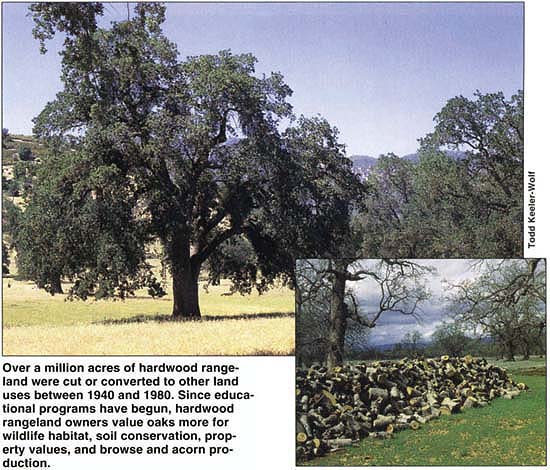All Issues
Private landowners critical to saving California biodiversity
Publication Information
California Agriculture 49(6):50-57. https://doi.org/10.3733/ca.v049n06p50
Published November 01, 1995
PDF | Citation | Permissions
Abstract
California has more than 2,000 kinds of unique plants and animals, making it the most biologically diverse region of the continental United States. Given the predicted increase in human population and the high cost of habitat preservation, we can only expect biological reserves to maintain a small fraction of the state's biodiversity. Just as most of our biodiversity is evenly scattered across the state, we need a conservation continuum to preserve these species across the wide range of present-day wildlands. Managing this continuum will be a huge task that depends on wildland stewardship by private landowners. One program designed to promote these goals through research, integrated management, and public education is the DANR Integrated Hardwood Range Management Program.
Full text
Left, if futurists are correct, the interface between wildlands and urbanization will continue to grow as California's economy and infrastructure shift to clusters of small cities and ranchette communities. Above, many reserves cannot function because they are isolated and often damaged by outside forces.
Two-thirds of endangered species listed by the federal government occur primarily on state, local or private land, according to a recently issued 1994 U.S. General Accounting Office (GAO) report. Similarly, the majority of California's federally listed endangered species occur on private lands, which constitute 95% of all nonfederal lands in the state. Because public sentiment has increasingly favored local control over federal regulation, the role of local governments and private landowners in conserving biodiversity has become more critical than ever.
Many of California's species are considered threatened because they have a limited distribution, often inhabiting only one or two counties. Other species are considered sensitive because they are susceptible to damage from human activities or require geographic linkages among habitats across large areas. In all three cases, we are unable to provide sufficient habitat for these species in reserves because the land is either unavailable or too expensive.
Furthermore, our rural landscape has become a mosaic of different land uses, varying from intensive agriculture to more-or-less native ecosystems. The majority of this habitat mosaic is privately owned land; hence survival of a large portion of California's biodiversity rests on the decisions and actions of landowners.
Most “endangered” state
California has more endangered species conflicts than any other state in the nation. We have over 160 species listed as endangered by the U.S. Fish and Wildlife Service, with the potential to list hundreds more. As of February 1995, there were 1,103 candidate species, 71 proposed species. In comparison, Texas, the state with the second most listings in the continental United States, has 72 endangered species. In addition, California has 17 of the 31 Habitat Conservation Plans (HCP) filed for “take” of endangered species nationwide. In an HCP, landowners agree to an overall plan to protect an endangered species and its habitat in exchange for a permit to convert or alter some portion of the habitat in the planning area (considered a “take” under the act).
The reason we have so many biodiversity conflicts in California is that we have more endemic plants and animals than any other area of North America. Endemic species are those that are found nowhere else and California has roughly as many unique plants and animals as the rest of the 48 contiguous states put together. More than 65 vertebrates, 1,500 plants and thousands of invertebrates are endemic to the state.
Diverse habitat are needed to preserve diverse species. Nelson's hairstreak (Mitoura nelsoni) butterfly relies entirely on J. occidentalis and incense cedar as larval hosts.
California's high number of endemic species is the result of geology and climate, both of which are more complex and variable here than anywhere else in the United States. For example, the precipitation gradient from mountain to desert can range from 2 to 45 inches in less than 10 miles. Such conditions have subjected California's plants and animals to strong evolutionary forces, producing and maintaining new varieties of plants and animals at a rate that is seldom matched in other parts of the continent. Second, a number of the state's plant and animal species have also shown a profound ability to differentiate. We have over 110 species of buckwheat (Eriogonum) in California, for instance, with 85 differentiated varieties that may become species in the future.
Third, there are a number of California species that have been able to persist due to the equitable, maritime climates of coastal areas. Southern Arizona, which rivals California's mix of biomes but lacks its equitable climate (characterized by even temperatures and precipitation), has about one-fifth the number of endemic species found in Southern California and about 60 endangered species.
Like many parts of the West, California maintained much of its biodiversity well into the 20th century. Steep topography prevented the wholesale conversion of natural habitats seen in midwestern, southern, and eastern states. California agriculture had to deal with summer drought, steep slopes and thin soils; as a result, much of the state was left relatively untouched. Similarly, the impact of wildland grazing in many of the state's rare habitats was restricted by steep terrain, limited water and poor forage.
Beginning in the 1920s, however, water projects finally allowed people to develop habitats that had remained virtually unchanged since Spanish colonization in the late 1700s. Today, California's biodiversity occurs and must be must be managed in thousands of pockets of unique habitat that are often unremarkable in their species numbers or scenic beauty. This pattern of scattered pockets has become the crux of our endangered species dilemma: a small change of land use is more likely to harm a rare species in California wildlands than in any other state. Even a small change in land use can harm a rare species or disrupt the physical and biological processes that maintain pockets of endemism.
Reserves in California
Can we maintain ecosystem and evolutionary processes in our biological reserves? Reserves are the linchpins of conservation in California. However, with so many unique habitats and species, we lack the financial and intellectual resources to even locate and select the habitats we should preserve, much less to purchase and manage them.
Despite 50 years of urban planning, we have not succeeded in separating sensitive natural areas from suburbs and land development (fig. 1). It has become painfully obvious that many reserves cannot function because they are isolated and often damaged by outside forces. If futurists are correct, the interface between wildlands and urbanization will continue to grow as California's economy and infrastructure shift to clusters of small cities and ranchette communities such as Grass Valley in the Sierra foothills and Jamul in San Diego County. As the state's population doubles to 63 million by 2040, it will take significant energy and resources to protect reserves from the damages of exotic species, recreation seekers, non-point-source pollution, and 8-year-olds with BB guns.
The conservation continuum
Nearly all current models of reserve design include a surrounding buffer zone of low-intensity use by humans as well as habitat linkage among reserves (Dyer and Holland 1991). However, low-intensity buffer zones and linkages are virtually impossible to create in California's fragmented wildlands. This is exemplified in figure 1, which shows San Diego County wildlands fragmented by urban, suburban and ranchette development.
In San Diego County and elsewhere, urbanization has moved unevenly into wildlands, creating vast amounts of edge. In San Diego County alone, the edge between wildland and urban areas extends more than 1,400 miles. The same is true for urbanized areas such as Orange County (fig. 2) and San Francisco Bay. The size and quality of wildlands left after land development varies from large tracts of pre-European (nearly native) habitat to small, disturbed patches embedded in commercial zones or housing. These privately owned habitats vary in size and intensity of use, so we must match conservation needs with the points on the continuum where we can be most effective.
In rural areas, the practice of dividing wildlands into small parcels (such as two, five or 10 acres) means that there can be hundreds of different landowners in a given area with an equally diverse set of land management goals. Residential enclaves often develop into “stealth cities” with no municipal infrastructure to deal with their urban problems. The combination of highly subdivided wildlands and the lack of community organization makes it difficult to locate and fund rural reserves. Voluntary actions of private landowners may be the only means of protecting habitats that extend across many property boundaries.
It would be best to protect large tracts of wildland, however, the fragmented nature of our remaining habitats demands that we develop voluntary methods of conserving species on lands put to other purposes. The only way to link habitat patches is to promote conservation activities on privately owned lands. Without rejecting the concept of reserves, we must work at many different points of the landuse continuum to maintain the maximum number of component habitats, processes and species. We need to create a conservation continuum using private land stewardship, conservation easements and open space to maintain the state's biological resources.
Private lands conservation
Habitats on private land represent a vast area that seldom falls under regulatory action or consideration for reserve acquisition. Current controversies over private land rights have shown that a nonregulatory approach may be more successful in conserving these habitats. Furthermore, conservation goals are often site specific, which requires agencies to work with a particular landowner whose property encompasses a rare species or wildlife corridor between two reserves. A beneficial decision by the landowner can maintain the habitat while a negative decision may lead to species extirpation (death of all individuals in a region) or even extinction.
Voluntary conservation on private lands can succeed if protecting biologically valuable resources is made more attractive than other options available to landowners. Conservation of private land can provide landowners with: (1) monetary benefits such as tax relief for donating lands or easements, (2) amenities such as the pleasure of living next to an aesthetic habitat and (3) the satisfaction of protecting community resources.
Techniques that provide landowners with monetary benefit in return for habitat protection are becoming common in California. Although habitat conservation does benefit landowners (e.g., protection of watershed, water quality and recreational value), the benefits are indirect and diffuse compared to the definable costs. This market failure has led to landowner compensation programs. For example, in exchange for a tax credit or other benefit (such as payment for an easement), a landowner may restrict development of some portion of his or her property. Ownership of the property remains unchanged, but land management in the deeded easement is passed to a second party. Many state parks create buffer zones with conservation easements on surrounding properties. County governments and a number of land-trust organizations are willing to accept these deeded easements.
Fig. 1. Wildland fragmentation in western San Diego County, 1990. Many habitat fragments are completely surrounded by developed areas.
Fig. 1. Pattern of habitat fragmentation in southern Orange County. Gray areas represent wildlands interspersed with urban development (white).
With or without financial incentives, conservation will ultimately depend on the land stewardship of private citizens, whether they are building birdhouses or setting aside wildlife corridors. Landowner education programs may be the best way to promote private lands conservation. For example, UC studies have shown that a property with woodlands can be anywhere from 20% to 50% more valuable than similar parcel without trees.
A wave of new ruralists has moved to wildlands for amenities such as open space, proximity of wildlife, nature-oriented recreation and scenic views. One of the great ironies of rural development, however, is that people who move into wildlands seeking such amenities make these lands incrementally more urban. Although new landowners may be very concerned about maintaining amenity values, they often have neither the experience nor the expertise to manage the sensitive biological resources on their properties.
The situation is further complicated if agencies or private individuals make inappropriate applications of laws intended to protect wildlife. In some cases, this has provided a rationalization for landowner destruction of precious biological resources. Both actions detract from community values and society's need to match civic responsibilities with the maintenance of personal rights.
The most effective way to help private landowners manage their land has proven to be the extension of university-based research through local outreach. Creating landowner partnerships with conservation agencies has emerged as the best system of creating monetary value for conservation actions. If we can establish biodiversity protection through land stewardship, we can maintain a large proportion of the state's plants and animals outside of reserves. If we fail, then no reserve will be large enough to make up for the loss.
Managing biodiversity locally
Although land management decisions have always been made by county governments, wildlife management decisions have always been made by state and federal agencies. Actions such as the formation of California's Natural Community Conservation Program (a voluntary program in which landowners receive development rights in exchange for preserving habitat) suggest a trend toward local control of wildlife with state and federal oversight. Local control translates into a critical need to develop local information networks to track biological resources. This means building regional expertise that includes databases of biological resources, and making these data and expertise available to private landowners, decision makers, and other stakeholders. Until recently, most data sources were centralized in Sacramento; however, the creation of the California Environmental Resources Evaluation System (CERES) in 1994 has helped local groups to develop regional databases, effectively dispersing the information sources throughout the state.
Biodiversity and DANR
The UC Division of Agriculture and Natural Resources (DANR) is uniquely situated to address biodiversity issues on private lands. The division has strong research programs on biodiversity and can use Cooperative Extension's (CE) existing outreach programs with private landowners and local governments. Several excellent examples of DANR's efforts already exist around the state (see sidebar, p. 55 ). Now our expertise is needed to develop local information networks, to maintain a research base, and to monitor conservation efforts. Equally important, we need to maintain the University's position as a nonregulatory, public trust institution that provides information on California's biodiversity. To resolve conservation conflicts, stakeholders need objective information to clarify biodiversity issues. They also need new management practices that blend biodiversity protection with economic enterprises.
UC's Division of Agriculture and Natural Resources is uniquely positioned to use its clientele base, county offices, and local credibility to help build these systems. For example, in the San Joaquin Valley, Kern County farm advisor Ralph Phillips is developing a landowner-based system of rare plant information which will provide data for regional decisions about species protection.
Reliable information created within a public trust institution, such as the Division, can provide the foundation for policy making by Californians at the local, regional and state levels.
Integrated programs
Hardwood rangelands encompass most of the habitats between urban areas and commercial timberlands, and are some of the most important wildlife habitats in the state. More than 80% of the state's hardwood rangelands are privately owned and while livestock grazing is the dominant land use, rural and suburban housing development are increasing rapidly. Over a million acres of hardwood rangeland were cut or converted to other land uses between 1940 and 1980. Public concern that oaks, the most common tree species in hardwood rangelands, and their habitats were declining through neglect led the DANR to initiate the Integrated Hardwood Range Management Program (IHRMP) in 1986. Policy makers, environmentalists, and landowner groups all saw that an integrated approach to hardwood issues would resolve more conflicts than the traditional system of individual programs, such as those in ranching, silviculture, endangered species and urban planning.
This partnership included the California Department of Forestry and Fire Protection (CDF) and Department of Fish and Game (CDFG), as well as the California Cattleman's Association and the California Native Plant Society. The California State Board of Forestry, with the authority to regulate hardwood loss, opted to support the IHRMP and stakeholders as a nonregulatory solution to hardwood conservation issues.
One of the IHRMP's first actions was to address the regeneration and maintenance of oak woodlands in California. Scientists including Mendocino County forest advisor Peter Passof, UC Berkeley forestry specialist Richard Standiford and UC Berkeley professor of range ecology James Bartolome identified the extent of the oak regeneration problem and the factors contributing to this lack of new trees. Their work showed that rather than being a statewide problem, lack of regeneration occurred in individual species under particular conditions such as low precipitation and altered vegetation. At the same time, a number of other scientists were investigating oak restoration techniques. Beginning in 1989, the combined results of these two groups were then extended to landowners through county agents and other educational groups such as the California Oaks Foundation.
UC Berkeley's Standiford and then-Mendocino County director Pete Passof showed that firewood cutting was only marginally profitable for most ranch owners. Several other economic enterprises — hunting clubs, equestrian trails or private camp-grounds — provided equivalent economic returns while maintaining owner options and biodiversity on ranchlands. Annual monitoring of firewood harvesting trends by CDF suggests a downward trend in both acreage and volume harvested since the inception of the IHRMP.
Issues of habitat conversion and fragmentation have become a primary concern in the IHRMP. Program research in Southern California and elsewhere has shown suburban growth to be the primary cause of hardwood loss. This has led to the creation of the IHRMP publication, A planner's guide for oak woodlands. This manual offers land-use planners a compilation of information designed to support woodland management in urbanizing areas.
One of the strongest aspects of the IHRMP has been increased public knowledge about woodlands. The effectiveness of educational programs was monitored by comparing hardwood rangeland owners' attitudes and management practices in 1992 to those in 1985. Oaks are now valued more for wildlife habitat, soil conservation, property values, and browse and mast (acorn production). The number of large-parcel owners (more than 500 acres) who cut living trees for forage enhancement declined from 58% to 38%; the number selling firewood decreased from 40% to 23%; and the number who improved wildlife habitat increased from 56% to 64%. In addition, landowners who received advice from CE or other public advisory services were more likely to carry out oak-promoting practices such as protecting sprouts.
Over a million acres of hardwood rangeland were cut or converted to other land uses between 1940 and 1980. Since educational programs have begun, hardwood rangeland owners value oaks more for wildlife habitat, soil conservation, property values, and browse and acorn production.
Where do we go from here?
Public policy discussions of biodiversity on private lands often mire in arguments over conflicting data. Interest groups array biological facts to support their positions, often with widely divergent conclusions. The data are not subjected to peer review and often fail to meet standards of scientific credibility. As a result, the public has lost confidence in environmental data, regardless of the source. Advocates in public policy arenas suggest that scientists can't be trusted because we are governed more by individual bias than collective wisdom.
Information is the currency of the university. The credibility of Division scientists depends on reestablishing public trust in the development of research-based information. Given that any interpretation of data may reflect a bias, DANR can provide the neutral forum for peer review and discussion among people with opposing viewpoints. UC scientists are in a position to supply research that has met the standards of scientific credibility, and to provide clear interpretations of data to all stakeholders in biodiversity conflicts.



